名词及所有格
- 格式:ppt
- 大小:636.00 KB
- 文档页数:22
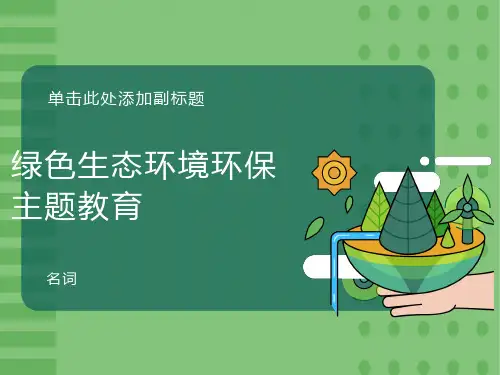
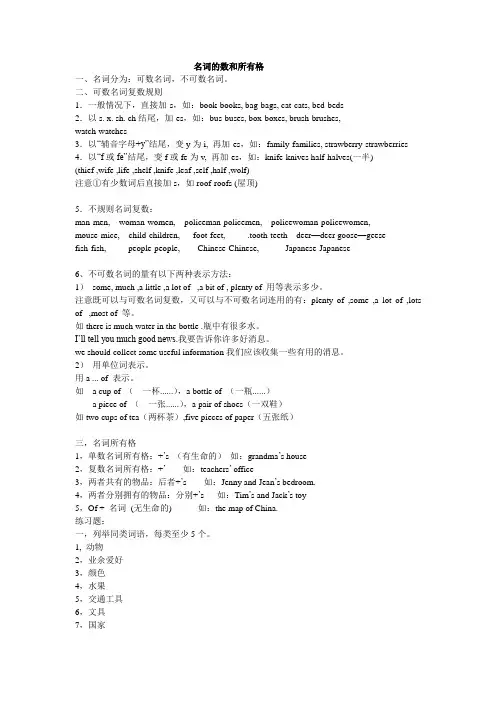
名词的数和所有格一、名词分为:可数名词,不可数名词。
二、可数名词复数规则1.一般情况下,直接加-s,如:book-books, bag-bags, cat-cats, bed-beds2.以s. x. sh. ch结尾,加-es,如:bus-buses, box-boxes, brush-brushes,watch-watches3.以“辅音字母+y”结尾,变y为i, 再加-es,如:family-families, strawberry-strawberries 4.以“f或fe”结尾,变f或fe为v, 再加-es,如:knife-knives half-halves(一半)(thief ,wife ,life ,shelf ,knife ,leaf ,self ,half ,wolf)注意①有少数词后直接加s,如roof-roofs (屋顶)5.不规则名词复数:man-men, woman-women, policeman-policemen, policewoman-policewomen,mouse-mice, child-children, foot-feet, .tooth-teeth deer—deer goose—geesefish-fish, people-people, Chinese-Chinese, Japanese-Japanese6、不可数名词的量有以下两种表示方法:1)some, much ,a little ,a lot of ,a bit of , plenty of 用等表示多少。
注意既可以与可数名词复数,又可以与不可数名词连用的有:plenty of ,some ,a lot of ,lots of ,most of 等。
如there is much water in the bottle .瓶中有很多水。
I’ll tell you much good news.我要告诉你许多好消息。
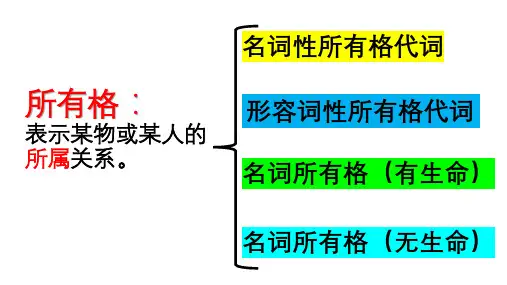

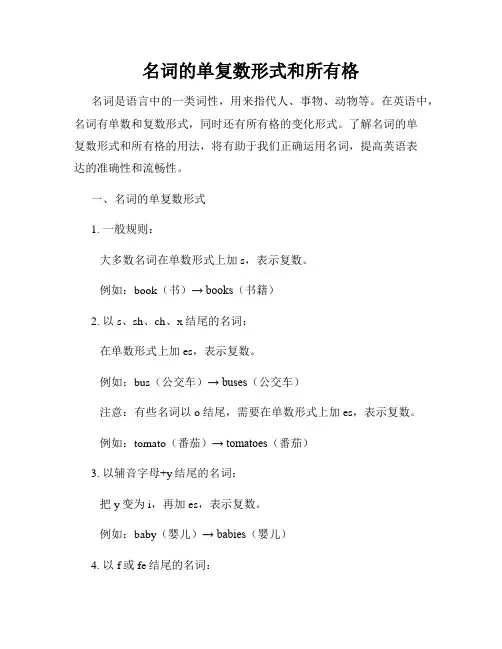
名词的单复数形式和所有格名词是语言中的一类词性,用来指代人、事物、动物等。
在英语中,名词有单数和复数形式,同时还有所有格的变化形式。
了解名词的单复数形式和所有格的用法,将有助于我们正确运用名词,提高英语表达的准确性和流畅性。
一、名词的单复数形式1. 一般规则:大多数名词在单数形式上加s,表示复数。
例如:book(书)→ books(书籍)2. 以s、sh、ch、x结尾的名词:在单数形式上加es,表示复数。
例如:bus(公交车)→ buses(公交车)注意:有些名词以o结尾,需要在单数形式上加es,表示复数。
例如:tomato(番茄)→ tomatoes(番茄)3. 以辅音字母+y结尾的名词:把y变为i,再加es,表示复数。
例如:baby(婴儿)→ babies(婴儿)4. 以f或fe结尾的名词:把f或fe变为v,再加es,表示复数。
例如:leaf(叶子)→ leaves(叶子)5. 有不规则变化的名词:一些名词没有明确的规律,需要记住它们的单复数形式。
例如:man(男人)→ men(男人)woman(女人)→ women(女人)二、名词的所有格名词的所有格用来表示所属关系或归属关系。
在英语中,一般在名词的后面加上's来表示所有格。
1. 单数名词的所有格:例如:cat(猫)→ cat's(猫的)2. 复数名词的所有格:一般在复数名词的后面加上'来表示所有格,不加s。
例如:cats(猫)→ cats'(猫的)3. 以s结尾的复数名词的所有格:在复数名词的后面加上's来表示所有格。
例如:students(学生)→ students'(学生的)4. 以s、sh、ch、x等结尾的复数名词的所有格:在复数名词的后面直接加上',不加s。
例如:buses(公交车)→ buses'(公交车的)5. 以辅音字母+y结尾的复数名词的所有格:把y变为i,再加es',表示所有格。
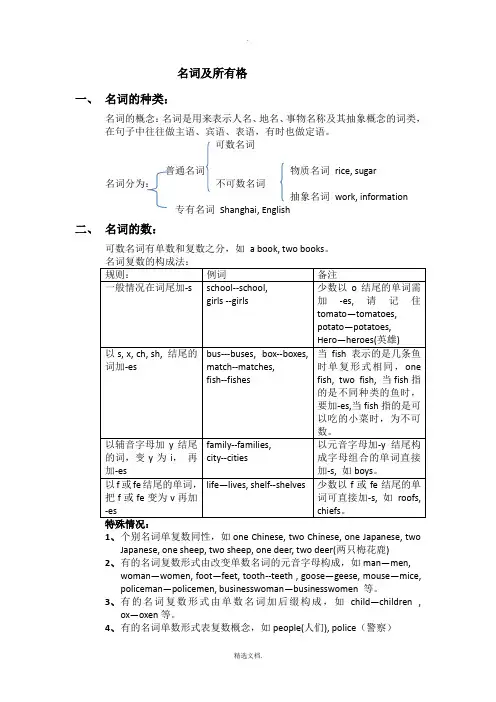
名词及所有格一、名词的种类:名词的概念:名词是用来表示人名、地名、事物名称及其抽象概念的词类,在句子中往往做主语、宾语、表语,有时也做定语。
可数名词普通名词物质名词rice, sugar 名词分为:不可数名词抽象名词work, information专有名词Shanghai, English二、名词的数:可数名词有单数和复数之分,如 a book, two books。
1、个别名词单复数同性,如one Chinese, two Chinese, one Japanese, twoJapanese, one sheep, two sheep, one deer, two deer(两只梅花鹿)2、有的名词复数形式由改变单数名词的元音字母构成,如man—men,woman—women, foot—feet, tooth--teeth , goose—geese, mouse—mice,policeman—policemen, businesswoman—businesswomen 等。
3、有的名词复数形式由单数名词加后缀构成,如child—children ,ox—oxen等。
4、有的名词单数形式表复数概念,如people(人们), police(警察)三、不可数名词及其数量的表示1.不可数名词没有复数形式,但paper 在作为报纸或讲义解释时为可数名词,news(消息)尽管以-s,结尾,实为不可数名词。
2.不可数名词可以用量词来修饰,如a piece of paper/news/ bread/meat a glass of milk/watera cup of tea a bottle of inktwo loaves of bread some advicea little work a lot of homework四、专有名词专有名词是表示具体的人名、地名或事物、机构等名称,通常第一个字母大写,且多不加冠词,但由普通名词构成的专有名词除外。
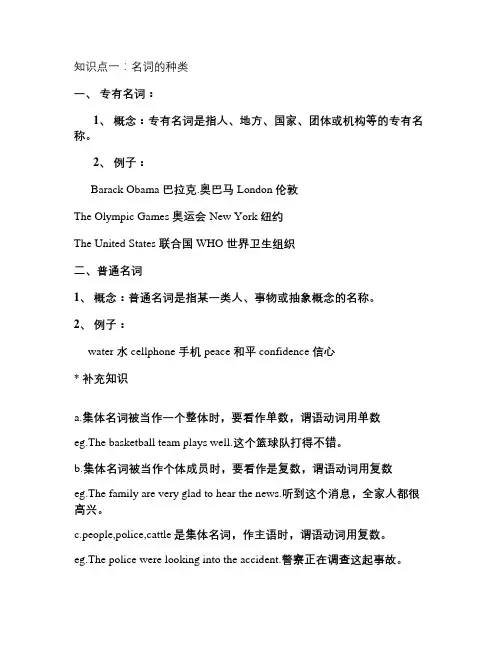
知识点一:名词的种类一、专有名词:1、概念:专有名词是指人、地方、国家、团体或机构等的专有名称。
2、例子:Barack Obama 巴拉克.奥巴马 London 伦敦The Olympic Games 奥运会 New York 纽约The United States 联合国 WHO 世界卫生组织二、普通名词1、概念:普通名词是指某一类人、事物或抽象概念的名称。
2、例子:water 水 cellphone 手机 peace 和平 confidence 信心* 补充知识a.集体名词被当作一个整体时,要看作单数,谓语动词用单数eg.The basketball team plays well.这个篮球队打得不错。
b.集体名词被当作个体成员时,要看作是复数,谓语动词用复数eg.The family are very glad to hear the news.听到这个消息,全家人都很高兴。
c.people,police,cattle是集体名词,作主语时,谓语动词用复数。
eg.The police were looking into the accident.警察正在调查这起事故。
知识点二:名词的所有格一、有生命物的名词的所有格1、单数名词和复数名词后不以s结尾的加’s;以s或es结尾的直接’即可。
如:his father’s car Children’s Day my parents’wish 2、表示各自所属时,在两个名词后分别’s;表示共同所有时,在最后一个名词后加’s。
如:Mary’s bike and Jack’s bike are very fashion.(玛丽和杰克的自行车都很时髦。
David and Susan’s house is v ery big.(戴维和苏珊的家很大3、表示店铺、某人的家、诊所、餐馆等所有格后的名词可以省略。
如:at the doctor’s 在诊所at Helen’s 在海伦家二、表示无生命的名词的所有格1、通常用“of+名词”的形式如:the chang of the weather 天气的变化the colour of the car 车的颜色2、表示时间、距离、价值、城市、国家等的名词,可以用’s表示所属关系如:today’s newspaper 今天的报纸Ten minutes’walk 十分钟的路程三、双重所有格:“of+名词’s”的所有格形式叫双重所有格。
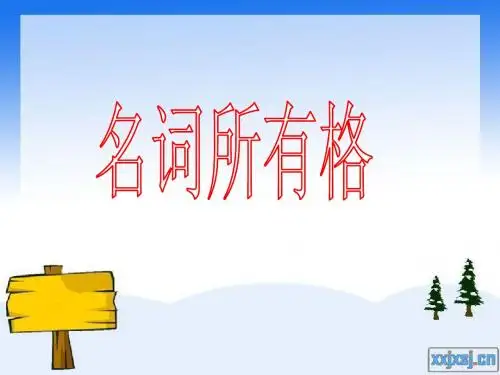
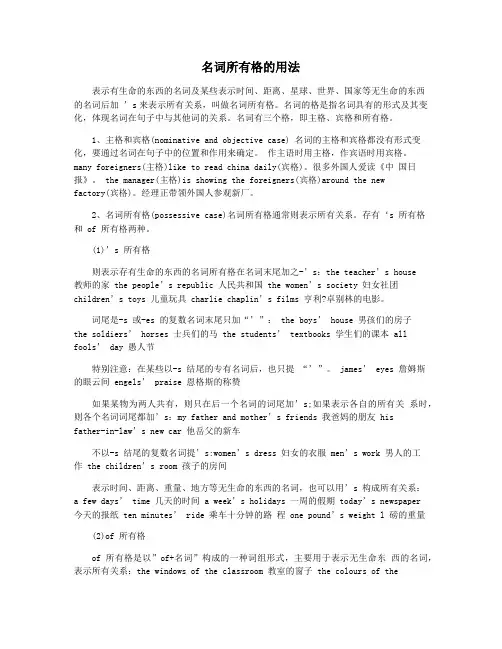
名词所有格的用法表示有生命的东西的名词及某些表示时间、距离、星球、世界、国家等无生命的东西的名词后加’s来表示所有关系,叫做名词所有格。
名词的格是指名词具有的形式及其变化,体现名词在句子中与其他词的关系。
名词有三个格,即主格、宾格和所有格。
1、主格和宾格(nominative and objective case) 名词的主格和宾格都没有形式变化,要通过名词在句子中的位置和作用来确定。
作主语时用主格,作宾语时用宾格。
many foreigners(主格)like to read china daily(宾格)。
很多外国人爱读《中国日报》。
the manager(主格)is showing the foreigners(宾格)around the newfactory(宾格)。
经理正带领外国人参观新厂。
2、名词所有格(possessive case)名词所有格通常则表示所有关系。
存有‘s 所有格和 of 所有格两种。
(1)’s 所有格则表示存有生命的东西的名词所有格在名词末尾加之-’s:the teacher’s house教师的家the people’s republic 人民共和国the women’s society 妇女社团children’s toys 儿童玩具charlie chaplin’s films 亨利?卓别林的电影。
词尾是-s 或-es 的复数名词末尾只加“’”:the boys’ house 男孩们的房子the soldiers’ horses 士兵们的马the students’ textbooks 学生们的课本 all fools’ day 愚人节特别注意:在某些以-s 结尾的专有名词后,也只提“’”。
james’ eyes 詹姆斯的眼云间engels’ praise 恩格斯的称赞如果某物为两人共有,则只在后一个名词的词尾加’s;如果表示各自的所有关系时,则各个名词词尾都加’s:my father and mother’s friends 我爸妈的朋友 hisfather-in-law’s new car 他岳父的新车不以-s 结尾的复数名词提’s:women’s dress 妇女的衣服men’s work 男人的工作the children’s room 孩子的房间表示时间、距离、重量、地方等无生命的东西的名词,也可以用’s 构成所有关系:a few days’ time 几天的时间 a week’s holidays 一周的假期today’s newspaper今天的报纸 ten minu tes’ ride 乘车十分钟的路程one pound’s weight l 磅的重量(2)of 所有格of 所有格是以”of+名词”构成的一种词组形式,主要用于表示无生命东西的名词,表示所有关系:the windows of the classroom 教室的窗子 the colours of theflowers 鲜花的颜色 the foot of the mountain 山脚 the noise of the tractors 拖拉机的噪音则表示存有生命东西的'名词,也需用 of 所有格则表示所有关系,或者则表示主谓关系、动宾关系或事物的来源等: the death of stalin 斯大林的去世 the arrival of the chairman 主席的到来 the laws of newton 牛顿定律3、名词所有格与它修饰的词的逻辑关系广义上来说所有格用以则表示“具有”或“所有”,the teachers’tapes(教师的磁带)。
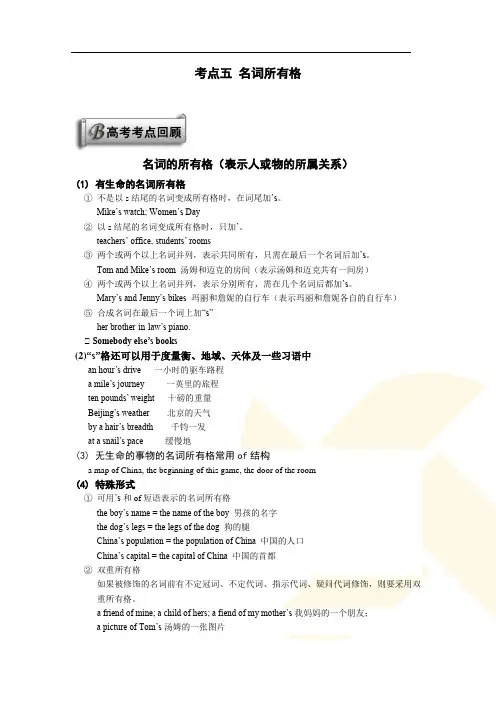
考点五名词所有格名词的所有格(表示人或物的所属关系)(1) 有生命的名词所有格①不是以s结尾的名词变成所有格时,在词尾加’s。
Mike’s watch; Women’s Day②以s结尾的名词变成所有格时,只加’。
teachers’ office, students’ rooms③两个或两个以上名词并列,表示共同所有,只需在最后一个名词后加’s。
Tom and Mike’s room 汤姆和迈克的房间(表示汤姆和迈克共有一间房)④两个或两个以上名词并列,表示分别所有,需在几个名词后都加’s。
Mary’s and Jenny’s bikes 玛丽和詹妮的自行车(表示玛丽和詹妮各自的自行车)⑤合成名词在最后一个词上加“s”her brother-in-law’s piano.⑥ Somebody else’s books(2)“s”格还可以用于度量衡、地域、天体及一些习语中an hour’s drive 一小时的驱车路程a mile’s journey 一英里的旅程ten pounds’ weight 十磅的重量Beijing’s weather 北京的天气by a hair’s breadth 千钧一发at a snail’s pace 缓慢地(3) 无生命的事物的名词所有格常用of结构a map of China, the beginning of this game, the door of the room(4) 特殊形式①可用’s和of短语表示的名词所有格the boy’s name = the name of the boy 男孩的名字the dog’s legs = the legs of the dog 狗的腿China’s population = the population of China 中国的人口China’s capital = the capital of China 中国的首都②双重所有格如果被修饰的名词前有不定冠词、不定代词、指示代词、疑问代词修饰,则要采用双重所有格。
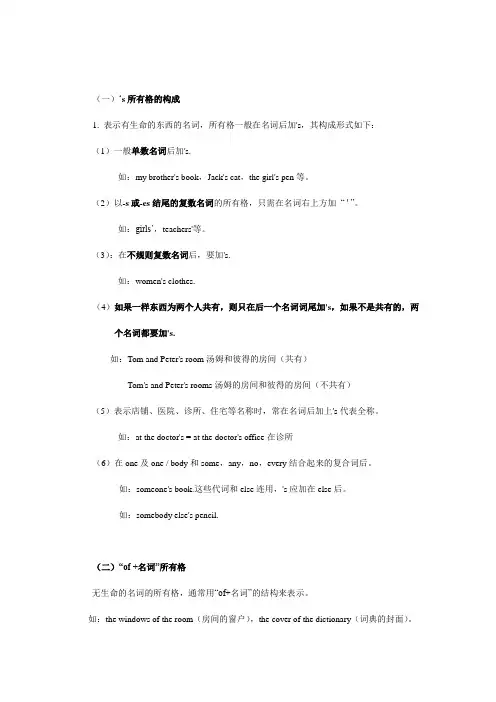
(一)…s所有格的构成1. 表示有生命的东西的名词,所有格一般在名词后加's,其构成形式如下:(1)一般单数名词后加's.如:my brother's book,Jack's cat,the girl's pen等。
(2)以-s或-es结尾的复数名词的所有格,只需在名词右上方加“ ' ”。
如:girls‟,teachers'等。
(3):在不规则复数名词后,要加's.如:women's clothes.(4)如果一样东西为两个人共有,则只在后一个名词词尾加's,如果不是共有的,两个名词都要加's.如:Tom and Peter's room汤姆和彼得的房间(共有)Tom's and Peter's rooms汤姆的房间和彼得的房间(不共有)(5)表示店铺、医院、诊所、住宅等名称时,常在名词后加上's代表全称。
如:at the doctor's = at the doctor's office在诊所(6)在one及one / body和some,any,no,every结合起来的复合词后。
如:someone's book.这些代词和else连用,'s应加在else后。
如:somebody else's pencil.(二)“of +名词”所有格无生命的名词的所有格,通常用“of+名词”的结构来表示。
如:the windows of the room(房间的窗户),the cover of the dictionary(词典的封面)。
名词及名词所有格专项练习I 写出下列名词的复数形式。
1.bag _______ 2.orange _______ 3.family _______ 4.wish _______ 5.leaf _______ 6.knife _______ 7.key _______ 8.baby _______ 9.tooth _______ 10.foot _______ 11.woman _______ 12.sheep _______ 13.Indian _______ 14.Japanese _______ 15.potato _______ 16.radio _______ 17.child _______ 18.fish _______ 19.Frenchman _______ 20.man doctor _______II. 选择填空。
三、名词的所有格:1、's 所有格:表示……的1)构成:A. 一般词尾+ ’s.:the teacher’s office, Xiao Li’s sister’s husband’sB. 以s 结尾的复数名词只+ ’ :workers’ rest room.C. 不以s结尾的复数名词加’s:children’s toys.D. 复合名词只在最后一个词的后面加’s:my sister-in-law’s brother.E. 表示共同所有的几个名词,只在最后一个词的后面加’s:This is Tom, James and Dick’s room.F. 表示各个所有关系的几个名词,在每个名词后分别加’s:Jenny’s, Jean’s and Mary’s rooms face to the south.G. 名词短语只在最后一个词后加’s:a quarter of an hour’s talk.2)用法:A. 名词所有格主要用于表示有生命的名词,表示所属关系:Lei Feng’s dairy.B. 用于表示时间的名词:today’s paper. an hour’s drive. Friday’s work.C. 用于表示地理、国家、城市等名词:the country’s plan. the farm’s fruit. China’s population.D. 用于表示由人组成的集体名词:our party’s standE. 用于表示度量、价值的名词:two dollars’ worth of books. a pound’s weight.2、of所有格:1)凡不能用’s 属格的情况可用of 属格表示所属关系:the City of New York. a map of China.2)下列情况通常要用of 属格:A. 当名词有较长的定语时:the name of the girl standing at the gate.Have you read the articles of the students who were with us yesterday.【难点】3、双重所有格:当of前面的名词有不定冠词、指示代词、疑问代词、不定代词或数词如a, an, this, that, these, those, two, three, four, any, some, several, no, few ,another等修饰时,用双重所有格,双重所有格只用于表示人的名词并且都是特指的:a poem of Lu Xun’s .a friend of his/hers .Which novel of Dicken’s are you reading ?some friends of my brothers’ .tickets for the film / moviea check for $1500.1. _________fathers are both scientists.[ 咸宁]A.Jim's and Bob B.Jim's and Bob's C.Jim and Bob's D.Jim and Bob[答案]B。
名词所有格详细讲解及练习题(附答案)名词所有格是用来表示所有关系、所属关系、动作执行者及动作承受者等意义的形式。
它包括's所有格、of所有格和双重所有格三种表现形式。
第一种形式是's所有格,主要用于有生命的事物或自然界独一无二的某些空间和时间名词的所有格。
单数名词和不以-s结尾的复数名词在词尾加's构成所有格,而复数名词以-s结尾的只需要加'构成所有格。
例如,Jimmy's book(XXX的书)、Twins' father is Mr。
Brown(双胞胎的爸爸是XXX)、the workers' struggle(工人的斗争)等。
第二种形式是of所有格,通常用于表示无生命的名词的所有关系。
例如,A bag of mine= my bag(我的书包)、The name of the girl=the girl's name(女孩的名字)、The window of the bedroom=the bedroom's window(卧室的窗户)等。
第三种形式是特殊所有格,用于表示一样东西为两人共有或各有各的情况。
若一样东西为两人共有,则后一个人名用所有格;如果不是两人共有,而是各有各的,则两个名词都用所有格,且其后名词应为复数。
例如,This is Tom and Jim'sroom(这是XXX和XXX共有的房间)、These are Tom's and Jim's rooms(这些是XXX和XXX各自的房间)、an hour and a half's walk(步行一个半小时的路程)等。
在's所有格中,所修饰的词有时会省略,例如,XXX's (book)is on the table(XXX的书在桌子上)。
需要注意的是,在使用名词所有格时,要根据不同的语境和语义来选择合适的形式,避免出现错误或歧义。
英语名词所有格英语名词中表示所有关系的形式叫名词所有格;所有格的构成有以下几种:一、'S结构表示所有关系1表示有生命的东西人或动物的名词所有格一般在名词后加'S;a child's dream 孩子的梦想;the children's room 孩子的房间;the horse's mouth 这匹马的嘴;Frank's new watch 冨兰克的新表;2 以-s或-es结尾的复数名词的所有格只在该名词的后面加“'”;the teachers' office 教师办公室;the masses' opinion 群众意见;the students'hotel 学生宿舍;3 以s结尾的姓氏可以用'S或单独使用“'”;Mr Jones's house 或Mr Jones' house 琼斯先生的住所;Burns's poems 或Burns' poems 彭斯的诗;4复合名词和由几个词组成的名词的所有格往往在最后一个名词的后面加上'S;my brother-in-law's photo 我姐妹夫的照片;the commander-in-chief's report 总司令的报告;Henrry the Eighth's wives 亨利八世的妻子;5 如果一样东西为两人共有,则只在最后一个名词的后面加'S;如果不共有,那么两个名词的后面各加'S;Marry and Peter's room 玛丽和彼得的房间;Marry's and Peter's room 玛丽的房间和彼得的房间;6 在一些与时间、地理、机构等有关的无生命名词之后也可以加'S表示所有格;today's newpaper 今天的报纸;a stone's throw 一箭之地;China's industry 中国的工业;Beijing's weather 北京的天气;our Party's stand 我们党的立场;7 除了表示所有关系之外,'S结构有时还有其他作用;〈a〉表示类别,如:a girl's school 为女孩子办的学校;〈b〉表示动作执行者,如:Scott's journey 斯科特所做的旅行;〈c〉表示动作承受者,如:my brother's promotion 我哥哥的被提升;〈d〉表示特征,如:John's stammer 约翰的口吃的毛病;8 's和s' 后的名词有时可以省略〈a〉所含的名词不言而喻My watch is better than Mary's. 我的手表比玛丽的表好;〈b〉指“某人家”at my ancle's 我叔叔家;at Wang's 王家;〈c〉指做某种生意的店铺the baker's 面包房;the chemist's 药店;the butcher's 肉店;the blacksmith's 铁匠铺;二、“of+名词”结构表示所有关系1无生命东西的名词的所有格一般用“名词+of+名词”结构来表示; the title of the book 书名;the windows of the house 房子的窗户;the depth of the ditch 沟的深度;2 指有生命的东西的名词较长或名词的定语较长时,也可以用of 词组来表示所有格;the works of Marx Engels Lenin Stalin 马、恩、列、斯著作;the excellent performance of the actor 演员的出色表演;英语中的“双重所有格”一、在英语句子中,名词of-phrase表示所有关系的格有两种形式1.句法形式:用of-phrase表示;一般来说这种形式多用在无生命的名词前;如:a map of China 一幅中国地图the state of being dirty 脏的状态2.词法形式:用-’s表示;一般来说这种形式多用在有生命的名词后;如:Li Ming’s book 李明的书men’s clothes 男人的衣服但有生命的名词有时两种形式均可;一般来说专有名词后宜用-’s 所有格当然所有格的名词较长时亦可用of 所有格,而表示动物的名词多用of 所有格;如:my sister’s name 或the name of my sister 我妹妹的名字Li Ming’s book 或the book of Li Ming 李明的书二、什么叫做“双重所有格”1.把上面表示所有关系的两种形式,of-phrase 和-’s,结合起来就构成了“双重所有格”double genitive;如:a play of Zhang Guo li’s 一出张国立的戏an English book of hers 她的一本英语书2.双重所有格也有两种形式:①of+名词所有格-’s;如:He is a schoolmate of my father’s. 他是我爸爸的同学;②of+名词性物主代词;如:I am a friend of his. 我是他的朋友三、双重所有格所表示的意义He is a friend of my brother’s.=He is one of my brother’s friends. 他是我兄弟的朋友;This is a picture of my gandfather’s=This is one of my gandfather’s pictures. 这是我祖父的一张照片;既是“一部分”就不可能是“全部”,所以that small nose of John’s 不是表示部分的意义,而是“约翰的小鼻子”,不是几个鼻子当中的一个,表示某种感情色彩;四、双重所有格的用法①of 前的名词必须是非限定的普通名词,不能是专有名词;如:不说the pen of Wei Pin’s,应说a pen of Wei Pin’s;不说desk of Mr Brown,应说Mr Brown’s desk;②of 前的名词有一个表示数量的词;如:a,two,some,any,no,few,several...We saw a play of Zh ang Guoli’s.我们看了一出张国立的戏;Have you read any books of Li Ming’s你读过李明的什么书吗③of 前的名词前可以有指示代词this,that, 表示某种感情色彩;this表示直接的,常常是同情性的关系;而that 常常含有否定甚至轻蔑的意味;如:this hand of mine 我的手不是this one of my two hands,而是this part of my boby that I cal l “hand”表自豪That answer of Li’s was not right.李的那个答案是不对的;表责备④of 前的名词前不能用the 限定;如:不说:The friend of my brother’s has gone abroad.可以说:A friend of my brother’s has gone abroad.或说:The friend of my brother’s who is an English teacher has gon e abroad.⑤of 后带-’s 结构中的名词必须是明确限定并且是指人的名词,或是名词性的物主代词;如:不说a leg of desk’s,应说a leg of desk;不说a play of write’s,应说a play of Zhang Guoli’s 或a play of his;。
名词的所有格形式名词的所有格形式表示名词与其所属的关系,在句子中起修饰和限定的作用。
所有格分为普通名词所有格和人名、地名、机构名的所有格两种形式。
一、普通名词所有格普通名词的所有格用于表示所属关系,一般在名词后面加上 "'s" 来表示。
如果名词以“s” 结尾,则只需在名词后加上“'”。
1. 单数名词的所有格当单数名词是普通名词时,通常在名词后加上 "'s"。
例如:- 我的父母房子的门是红色的。
(My parents' house's door is red.)- 那只猫的尾巴很长。
(The cat's tail is very long.)- 今天早晨的鸟儿们的歌声非常美妙。
(The birds' songs this morning are really beautiful.)2. 复数名词的所有格当复数名词是普通名词时,通常在名词后加上“'”。
例如:- 这些孩子的书包都很重。
(The children's backpacks are all heavy.) - 我们公司的车辆停在前面。
(Our company's vehicles are parked in the front.)- 请把这些学生的作业本分发给他们。
(Please distribute these students' workbooks to them.)二、人名、地名、机构名的所有格人名、地名和机构名的所有格与普通名词的所有格形式不同,一般在名词后面加上“'”。
例如:1. 人名的所有格当表示一个人名的所有格时,通常在名字后面加上“'”。
例如:- 约翰的车停在外面。
(John's car is parked outside.)- 小玛丽的房间里有很多玩具。
(Mary's room is filled with many toys.) - 我们参观了凯瑟琳的工作室。
第一讲名词知识讲解(一)名词1.概念:名词是表示人、地方、事物或抽象概念名称的词,可以说名词是万物之名称。
它们可以是:人的名字Li Ming, Tom 地方名称China, London 职业称呼teacher, doctor 物品名称pencil, dictionary 抽象概念history, grammar2.名词的分类专有名词&普通名词可数名词&不可数名词1)专有名词表示个别的人、事物、地点等专有的名称。
【注】专有名词第一个字母要大写如:Mary,Beijing,Americans, English,May, Saturday…2)普通名词除专有名词外,其它都属于普通名词。
如:boy,classroom,book, bag, aunt, family, juice, milk, age, childhood…随堂练习一:分类,专有名词(√)or 普通名词(×)Saturday, tea, Zhanghua, rain, West Lake,enemy, computer, beauty,Mrs. Green,weather, peace, ice-cream, Russians,3)可数名词(countable noun)可以分清个体,以数目来计算的,有复数形式。
如:book, girl, ruler, room, apple, box, bus, watch, day, zoo…4)不可数名词(uncountable noun)不可以分清个体,不能以数目来计算,只有单数形式。
如: water, milk, coffee, tea, rice, bread, work, study, love随堂练习二:可数名词(√)or 不可数名词(×)boy, knife, peace, potato, wind, tomato, hero, music, pleasure, map, radio, 【注】既可以当可数名词又可以当不可数名词:glass 玻璃杯,眼镜玻璃paper 报纸,试卷纸张time 次数,时代orange 橘子橙色【重要】可数名词的复数形式1)规则变化:①一般情况在词尾加-s:desk→desks ;day→days;girl→girls②以s, x, ch, sh结尾的词在词尾加-es:bus →buses;box→boxes;watch→watches③以辅音字母加y结尾的词变y为I再加-es:family→families factory→factories party→parties④以f或fe 结尾的词变f或fe为v再加-es: knife→knives; life→lives; wife→wives; half→halves随堂练习三:写出下列名词的复数形式:1.house ________2. village _______3. map __________4. orange _________5. bag ___________6. dish __________7. family ___________8. boy ___________9. monkey __________ 10. box __________ 11. knife __________ 12. class __________ 13. factory _________ 14. leaf__________ 15. dictionary __________ 16. watch _________【注】不规则变化:①以o结尾加-es:potato→potatoes tomato→tomatoes hero→heroes Negro →Negroes…②字母a变e: man→men, woman→women, Frenchman→Frenchmen, policeman-policemen…③字母oo变ee: tooth→teeth, foot→feet, goose→geese…④单复数同形:sheep→sheep, deer→deer, fish→fish Chinese-Chinese, Japanese →Japanese⑤其他:child→children, mouse→mice, medium →media, basis →bases…4.不同国籍的人的复数形式:1)加-s: Australian Australians Russian Russians Italian Italians Greek Greeks American Americans Indian Indians Canadian Canadians2)变a为e:Englishman Englishmen Frenchman Frenchmen3)单复数同形:Chinese Chinese Japanese Japanese秘诀:中日不变英法变,其他S加后面随堂练习四:写出下列名词的复数形式:1.match __________2. man _________3. German __________4. tomato _________5. policeman ________6. kilo __________7. human _________8. potato ___________9. Chinese __________ 10. shelf __________ 11. Japanese _______ 12. American________13. life ___________ 14. tooth __________ 15. wife ___________ 16. foot ___________17. knife __________ 18. sheep __________ 19. half ___________ 20.key_____________ 一,名词单复数专项练习1.There are two__________ over there. (watch)2.l can see a __________and two __________ standing there. (man, woman)3.There are two baskets of__________ on the floor. (apple)4.How many __________can you see? (radio)5.There are more and more __________ drivers in Shanghai now. (woman)6.Give me some __________, please. (water)8. I have two____________ (knife)9. There are many ___________ here. (box)10. There are many ___________ on the road. (bus)11. A few ___________ are drawing on the wall. (boy)12. The ______________ are playing football now. (child)13. Please take two _______________ for me. (photo)14. I like the red ________________.(tomato)15. Would you please clean your _____________ now? (tooth)16. Do you want some ___________? (milk)17. There are ten ___________________in our school. (woman teacher)强化练习:一、单项选择( )1. The __ in our yard are very beautiful.A. clothB. waterC. flowers( )2. Tom is one of the Chinese _____ in our school.A. boyB. boysC. boies( )3. A cat has four ____ , doesn't it?A. footsB. feetC. feets( )4. There are three ____ and five _____ in the room.A. American, Japanese B Americans, Japanese C. American, Janpaneses ( )5. Can you see nine ____ in the picture?A. fishB. bookC. horse( )6. The _____ has two______.A. boy; watchB. boy; watchesC. boys; watch( )7. The _____ are flying back to their country.A. GermanyB. GermanysC. Germans( )8. The girl brushes her _____ every day before he goes to bed.A. toothsB. teethC. teeths( )9.I saw many _____ in the street.A. peoplesB.peopleC.people’s第二讲名词所有格讲解一,定义:有些名词可以加“’s”来表示所有关系,带这种词尾的名词形式称为该名词的所有格如:a teacher’s book。